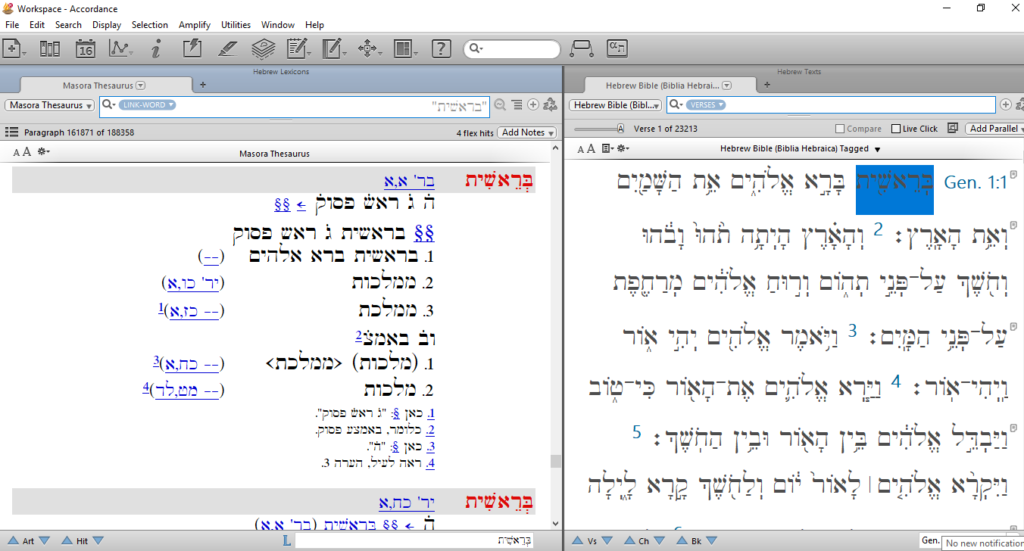Yet, another reason to get excited about Accordance for Windows and the original Mac OS version as well! Accordance has just released the first part of the Masora Thesaurus. When completed this encyclopedic like volume will contain the complete text of the Masorah Gedolah, Masorah Ketanah, and the Masorah Finalis of the oldest complete codex of the Hebrew Bible/Tanakh known as the Leningrad Codex B19a. This work will also include 30 years worth of Aron Dotan’s notes on the Masora. Aron Dotan is chair of the International Organization for Masoretic Studies and editor of the Biblia Hebraica Leningradensia. Now, this begs the question of what is the Masora?
The term Masorah is ordinarily used in modern biblical studies to refer to the body of marginal notes (i.e., Masoretic notes) which are transmitted with the text, either in a manuscript or in a printed edition. However, this is the narrow sense of the word. In its broadest sense, Masorah refers to traditions and rules, passed down in Judaism for generations, which regulate all aspects of the copying and use of Bible manuscripts…
The Masorah can be divided into several subdivisions. The Masorah Parva (Mp) consists of the Masoretic notes in the side margins of manuscripts (cf. BHS). The Masorah Magna (Mm) includes the notes in the upper and lower margins of the manuscripts…
The Masorah Finalis (Mf) refers to the material collected at the end of a particular book, section (e.g., Torah) or manuscript. In manuscripts, the Mf consists of summary lists, such as the number of verses, sedarim, etc., and information of this type is included in BHS at the end of books.
Kelley, Page H., Daniel S. Mynatt, and Timothy G. Crawford. The Masorah of Biblia Hebraica Stuttgartensia: Introduction and Annotated Glossary. Grand Rapids, MI: William B. Eerdmans Publishing Company, 1998.
The Biblia Hebraica Stuttgartensia (BHS) the longtime popular edition of the Hebrew Bible. only contains the Masora Parva, Masora
Enter Accordance Bible Software‘s Marorah Thesaurus database.

The Masorah Thesaurus has so much more than the printed Masora Magna of the BHS. Accordance database has the unedited Masorah Parva, the Masorah Magna of the Leningrad Codex(AND other Manuscritpt, too), as well cross-references to other Masoretic lists, notations, and texts (as well as much more). Accordance digital Masorah Thesaurus database is, of course, searchable in ways that neither the print edition of the BHS nor the standard digital edition of Gerard E. Weil’s Massorah Gedolah: Manuscrit B. 19a de Léningrad are.
So, that we can better appreciate the Masorah Thesaurus let’s first take a quick look at what the printed BHS offers.
In a printed edition of the BHS we turn to page one or to Genesis 1:1. Now, we notice the raised circle above בְּרֵאשִׁית . That circle in our printed BHS alerts us to the marginal notes called Masora Parva. To better illiterate what has just been said take a look at the following screenshot:

In the photo above (or in the BHS) we notice that the f
We, also notice that there are two other Hebrew letters in the note with dots; both ג̇ and ב̇ followed by abbreviations or short hand notes. ג̇ being the third letter of the alphabet represent 3, and ב̇ being the second letter represents two (2 plus 3 is of course five). So, the Masora tells us that בְּרֵאשִׁית starts a stanza(ר״פ) three times (ג̇) , and is embedded in a stanza ( מ״פ) two times(ב̇).
This may help us understand the above abbreviations:
(Within, inside) מ = מצעא
(Head, start) רֹ =ראש
(verse/Stanza) פ = פסוקֹ, פסֹ, פסוֹ
Sometimes (or at least I have seen some use) קֹ in place of פסוקֹ
However, since the Masora

Unfortunately, Weil’s Massorah Gedolah is out of print, but as mention before there is a digital version of it in another software platform for 99.99USD. However as Accordance Bible Software Masora Thesaurus just about the same at 99.09 it is arguable the better deal because it contain so much more value for the buck.